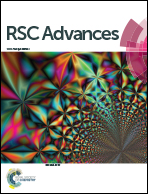Towards applications in catalysis: investigation on photocatalytic activities of a derivative family of the Keplerate type molybdenum–oxide based polyoxometalates†
Abstract
The photocatalytic potential of a derivative family of the Keplerate type nano-porous Mo–O based polyoxometalates with general formula [Mo72VIMo60VO372(L)30(H2O)72]n− (L = CH3COO−, SO42−) (denoted Mo132) has been evaluated by a prototype photocatalytic decoloration reaction of aqueous rhodamine B. The Mo132 anions are found to be photocatalytically active centers, however they are unstable and subjected to decomposition in the solution form. The introduction of organic counter cations such as tetrabutylammonium (n-Bu4N+) and dioctadecyldimethylammonium (DODA+) can endow significant stability to the giant anions during the catalytic process. TOC changes and GC/MS measurements were done to identify the degradation products. Among the derivatives, compound 2 composed of n-Bu4N+ and Mo132 (L = CH3COO−) has been found to be the most active one towards the photocatalytic decoloration of RhB solution. The analytical mechanism indicates that both OH radicals and 1O2 participate in the photo degradation process.


 Please wait while we load your content...
Please wait while we load your content...